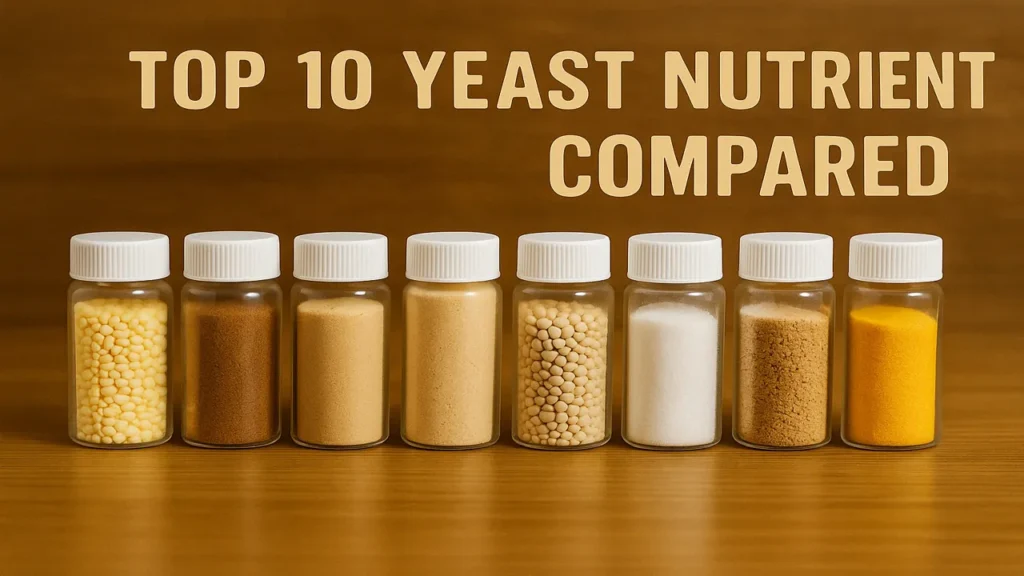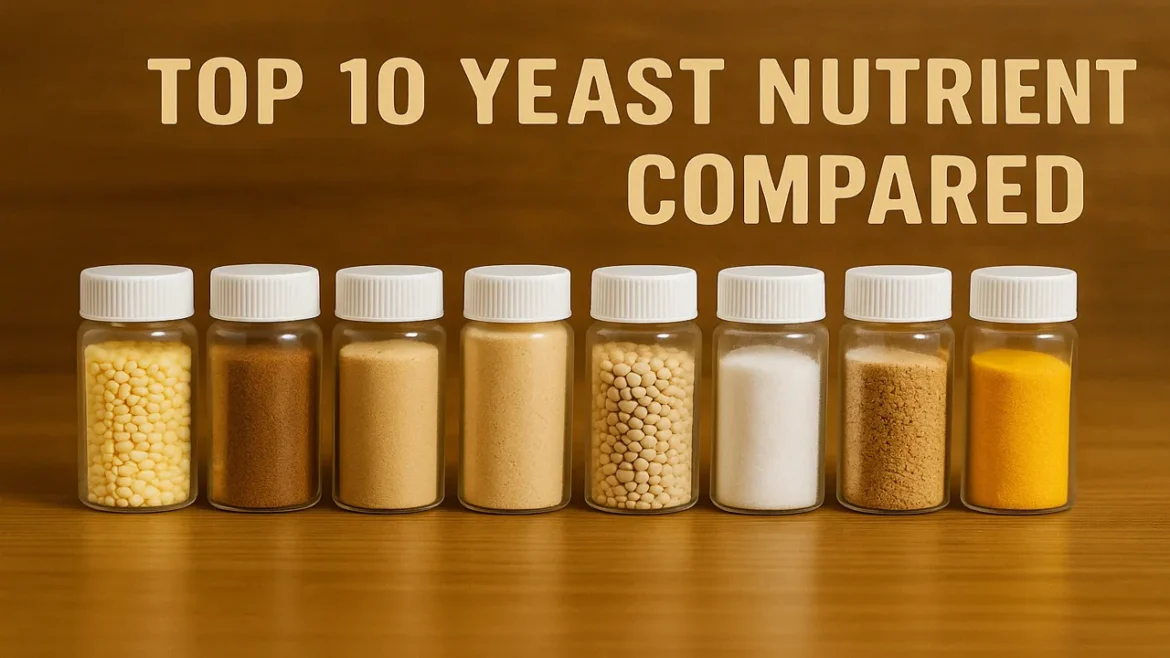Discover the top 10 yeast nutrients for homebrewing and how they can transform your beer, mead, and cider. Compare ingredients, benefits, and proper dosing with our interactive calculator!

Whether you’re brewing your first batch of beer or you’re a seasoned homebrewer looking to perfect your craft, one thing remains constant: healthy yeast equals better beer. If you’ve ever experienced a stuck fermentation or off-flavors in your homebrew, inadequate yeast nutrition might be the culprit. In this comprehensive guide, we’ll explore the top 10 yeast nutrients available to homebrewers, comparing their composition, effectiveness, and ideal brewing applications.
Why Yeast Nutrients Matter in Homebrewing
Yeast are living microorganisms that do the heavy lifting in brewing, converting sugars into alcohol and CO2. Like all living things, yeast need proper nutrition to thrive. While malt wort provides many essential nutrients, some brewing scenarios—particularly high-gravity beers, meads, ciders, or wines—can benefit significantly from supplemental nutrition.
According to White Labs, proper yeast nutrition can:
- Reduce lag time before active fermentation
- Promote complete fermentation (reducing the risk of stuck fermentation)
- Minimize stress-related off-flavors
- Improve yeast health for potential harvesting and reuse
- Enhance flavor profile and consistency
As Dave Hopson, our Beer Culture & Trends Analyst, often says, “Treating your yeast well is the single most important factor in producing consistent, high-quality homebrew.”
Understanding Yeast Nutritional Needs
Before diving into specific products, let’s understand what yeast actually need:
| Nutrient Type | Function | Natural Sources in Brewing |
|---|---|---|
| Free Amino Nitrogen (FAN) | Basic building blocks for yeast reproduction and enzyme production | Malted barley (limited in adjunct brews) |
| Vitamins | Metabolic functions and stress resistance | Malt, but can be depleted during wort production |
| Minerals | Enzyme cofactors and cellular function | Water and malt (varies widely) |
| Oxygen | Essential for cell membrane synthesis | Added through aeration/oxygenation |
| Zinc | Critical for enzyme activity | Often deficient in modern wort |
For a deeper dive into the biochemistry of fermentation, check out our article on The Science Behind Fermentation & Yeast Selection.
Top 10 Yeast Nutrients for Homebrewers
1. Fermaid K
Composition: A blended complex nutrient containing inorganic nitrogen (DAP), organic nitrogen from inactivated yeast, amino acids, sterols, and micronutrients.
Best For: All-purpose use in beer, wine, mead, and cider. Particularly valuable for high-gravity beers and meads.
Dosage Rate: 1 gram per gallon (typical)
Pros:
- Balanced nutrition from multiple sources
- Contains critical micronutrients
- Staged additions can optimize fermentation
- Reduces sulfur production
Cons:
- More expensive than single-ingredient nutrients
- Can cause foaming when added to active fermentation
Fermaid K stands out for its comprehensive nutritional profile. According to Tyler Yeastman, our Microbiology Expert: “Fermaid K provides both immediate nitrogen from DAP and sustained nutrition from the yeast hulls. This makes it my go-to for challenging fermentations like high-gravity brewing.”
2. Wyeast Nutrient Blend
Composition: Contains diammonium phosphate (DAP), yeast hulls, magnesium sulfate, and vitamins.
Best For: Beer fermentations, particularly lagers and high-gravity styles.
Dosage Rate: 1/2 teaspoon per 5 gallons
Pros:
- Specifically formulated for beer fermentations
- Easy to use in powder form
- Widely available at homebrew shops
- Improves yeast viability during cold fermentations
Cons:
- Less customizable than individual components
- Not ideal for wild fermentations
Wyeast’s blend has been formulated specifically for beer applications, making it particularly valuable for traditional brewing. The magnesium content supports enzyme function, which can be especially important during lagering.
3. GoFerm Protect Evolution
Composition: Inactivated yeast with higher micronutrient content, particularly sterols and fatty acids.
Best For: Yeast rehydration and difficult fermentation conditions.
Dosage Rate: 1.25 grams per gram of dry yeast
Pros:
- Significantly improves yeast viability
- Protects yeast during rehydration
- Enhances stress resistance during high-alcohol fermentation
- Contains no added DAP (all organic nitrogen)
Cons:
- Only used during rehydration phase
- More expensive than basic nutrients
- Requires precise temperature management
GoFerm differs from other nutrients in that it’s designed specifically for the rehydration phase. Studies conducted by Lallemand have shown up to 30% improvement in yeast viability when GoFerm is used properly during rehydration.
4. Servomyces (Yeast Fuel)
Composition: Zinc-enriched inactivated yeast.
Best For: All beer styles, especially when using highly modified malts or adjuncts.
Dosage Rate: 1 capsule per 5-10 gallons
Pros:
- Provides bioavailable zinc, often deficient in modern wort
- Enhances yeast metabolism
- Reduces lag time
- Very clean profile with minimal impact on flavor
Cons:
- Single-focus supplement (primarily zinc)
- May not address all nutritional needs
- Higher cost per batch than basic DAP
Mark Kegman, our Product Tester, notes: “In our controlled trials, Servomyces consistently produced faster starts and more complete fermentations across various beer styles. It’s especially valuable when working with pilsner malt or adjunct-heavy recipes.”
5. Diammonium Phosphate (DAP)
Composition: Inorganic nitrogen source (NH4)2HPO4.
Best For: High-gravity brewing, mead, wine, and cider.
Dosage Rate: 1 gram per gallon (varies by application)
Pros:
- Inexpensive
- Provides readily accessible nitrogen
- Dramatically reduces lag time
- Easily measured and dosed
Cons:
- Can cause too-rapid fermentation if overused
- No micronutrients, vitamins, or minerals
- Can contribute to off-flavors if used exclusively
- Not ideal for organic brewing
DAP is the most basic yeast nutrient and provides only inorganic nitrogen. While effective at boosting fermentation rate, research from the American Society of Brewing Chemists suggests that exclusive DAP use can contribute to yeast stress and potential off-flavors in the finished product.
6. Yeast Energizer
Composition: Typically a blend of DAP, yeast hulls, B vitamins, and trace minerals.
Best For: Rejuvenating sluggish fermentations and high-gravity brewing.
Dosage Rate: 1/2 teaspoon per 5 gallons
Pros:
- More complete nutrition than DAP alone
- Effective at restarting stuck fermentations
- Readily available at homebrew shops
- Cost-effective general purpose nutrient
Cons:
- Varied formulations between brands
- Not as balanced as premium nutrients
- Can cause excessive foaming if added during active fermentation
Yeast Energizer functions similarly to Fermaid K but with slightly different formulations depending on the manufacturer. It’s particularly useful for rejuvenating stuck fermentations.
7. Yeast Hulls (Ghosts)
Composition: Cell walls from inactivated yeast.
Best For: Rescuing stuck fermentations, high-alcohol environments, and detoxifying inhibitory compounds.
Dosage Rate: 1-2 grams per gallon
Pros:
- Adsorbs toxic fatty acids and inhibitory compounds
- Provides nucleation sites in sluggish fermentations
- Releases small amounts of amino acids and sterols
- Helps with yeast dispersion
- Completely natural product
Cons:
- Limited nutritional value on its own
- Can increase lees volume
- Not a complete nutrient solution
According to Sophia Chen, our Beer Chemistry Specialist: “Yeast hulls work by adsorbing medium-chain fatty acids that can become toxic at higher concentrations. This detoxification effect makes them particularly valuable when rescuing stuck fermentations or working with high-alcohol beverages.”
8. Fermax
Composition: Blend of DAP, food-grade urea, yeast hulls, B vitamins, and trace minerals.
Best For: All-purpose use, particularly for meads and wine-like fermentations.
Dosage Rate: 1 teaspoon per gallon
Pros:
- Complete nutritional profile
- Good price-to-performance ratio
- Improves yeast tolerance to alcohol
- Available in convenient pre-measured packets
Cons:
- Contains urea (not allowed in commercial brewing)
- Can cause excessive foaming
- Less specific than specialized nutrients
Fermax has been a staple in homebrewing for decades. Its urea content provides a sustained nitrogen release but does make it unsuitable for commercial brewing applications due to regulatory restrictions.
9. Fermaid O
Composition: 100% organic nitrogen from inactivated yeast with no added DAP.
Best For: Complex fermentations where clean flavor profiles are essential.
Dosage Rate: 1 gram per gallon
Pros:
- All-organic nitrogen source
- Promotes cleaner fermentation profiles
- Reduces risk of off-flavors from nutrient-related stress
- Compatible with “organic” brewing standards
Cons:
- More expensive than conventional nutrients
- Slower initial impact than DAP-containing products
- May require larger doses for same nitrogen level
Fermaid O represents the evolution of yeast nutrition, focusing on organic nitrogen sources that more closely mimic natural wort composition. The Scott Laboratories technical data sheet indicates that Fermaid O produces fewer off-flavors and fusel alcohols compared to DAP-based nutrients.
10. Custom Nutrient Blends
Composition: Varies by recipe, typically combining multiple elements above.
Best For: Advanced brewers tailoring nutrition to specific styles and conditions.
Dosage Rate: Varies by formulation
Pros:
- Fully customizable to fermentation needs
- Can be optimized for specific yeast strains
- Potentially more cost-effective for frequent brewers
- Adaptable to changing brewing conditions
Cons:
- Requires advanced knowledge of yeast nutrition
- More complex preparation and storage
- Risk of imbalanced nutrition without proper formulation
Many experienced homebrewers eventually develop their own nutrient strategies, combining elements from commercial products based on their specific brewing practices and observations.
When to Add Yeast Nutrients
Proper timing of nutrient additions can significantly impact fermentation performance. Here’s a general guideline:
| Nutrient Type | Ideal Addition Time | Notes |
|---|---|---|
| GoFerm | During yeast rehydration | Before pitching yeast |
| Fermaid O | At pitch and 24-48 hours | Staggered additions recommended |
| Fermaid K | At 1/3 sugar break | Can cause foaming during active fermentation |
| DAP | Early fermentation (first 1-3 days) | Not recommended late in fermentation |
| Yeast Hulls | Any time, especially for stuck fermentations | Most effective when fermentation slows |
| Servomyces | At pitch | Single addition |
Nutrient Calculator for Perfect Dosing
Use our interactive yeast nutrient calculator to determine the optimal amount for your specific brew:
Yeast Nutrient Calculator
Which Yeast Nutrient Is Right for Your Brew?
The ideal nutrient depends on your specific brewing scenario:
For Standard Beers (OG < 1.060)
- Best Choice: Wyeast Nutrient or Servomyces
- Why: Most beer wort already contains adequate nutrition, but a small boost improves consistency
For High-Gravity Beers (OG > 1.080)
- Best Choice: Fermaid K or combination approach
- Why: Higher alcohol environments create stress that requires comprehensive nutrition
For Mead and Wine
- Best Choice: Staggered nutrient approach using GoFerm for rehydration and Fermaid O/K during fermentation
- Why: Honey and fruit lack many essential nutrients found in malt
For Stuck Fermentations
- Best Choice: Yeast Hulls followed by gentle energizer addition
- Why: Detoxification must happen before new nutrition can be effective
According to John Brewster, our Lead Brewer: “I’ve found that a combination approach using GoFerm during rehydration followed by small, staggered additions of Fermaid O produces the cleanest fermentation profiles across most beer styles. The extra effort pays dividends in flavor quality.”
Potential Issues with Yeast Nutrients
While proper nutrition is essential, there are some pitfalls to be aware of:
- Over-nutrition – Too much nitrogen can lead to excessive yeast growth, off-flavors, and potential contamination risks
- Late additions – Adding DAP late in fermentation can result in unmetabolized nitrogen and encourage spoilage organisms
- Foaming – Adding powdered nutrients to active fermentation can cause vigorous foaming and potential overflow
- Flavor impact – Some nutrients, particularly those containing DAP, can impart subtle flavor changes if used excessively
To avoid these issues, follow manufacturer guidelines for dosage rates and always consider the specific needs of your brewing scenario.
Investing in Yeast Health Pays Dividends
The difference between good beer and great beer often comes down to fermentation quality. While it’s possible to brew without supplemental nutrients, understanding and implementing proper yeast nutrition will elevate your homebrewing to new heights.
As Tyler Yeastman puts it: “Your yeast are microscopic employees working tirelessly to create your beer. Providing them with proper working conditions and nutrition isn’t just good brewing practice—it’s good management.”
By selecting the right nutrients for your specific brewing needs and implementing proper addition timing, you’ll experience fewer stuck fermentations, cleaner flavor profiles, and more consistent results.
For more advanced brewing techniques, check out our article on Understanding Water Chemistry for Brewing.
What’s your experience with yeast nutrients? Have you found a particular product or approach that works best for your brewing style? Share your thoughts in the comments below!
About the Author:
Tyler Yeastman is a microbiologist who left his lab job to explore the fascinating world of wild fermentation. He maintains a library of over 100 isolated wild yeast strains and bacterial cultures collected from around the world. Tyler specializes in lambic-style beers, spontaneous fermentation, and mixed-culture brewing that produces complex, terroir-driven flavors. His home lab includes custom equipment for yeast propagation and analysis. Tyler frequently collaborates with local breweries to develop signature house cultures based on microorganisms native to their environments.

